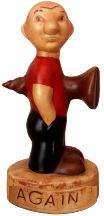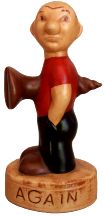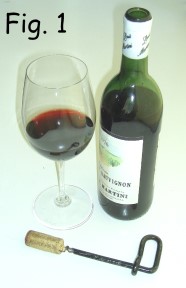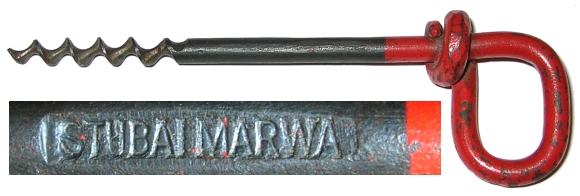 |
 The Virtual Corkscrew Museum's Weekly Newspaper |
 |
 |
 The Virtual Corkscrew Museum's Weekly Newspaper |
 |
|
Sunday, September 30, 2007 |
Number 481 |
Glacial Screw!
by Ed Bystran

Recently I spotted a corkscrew (?) at a Reno, Nevada antique store. I've noticed similar items, with the same offset handle, for sale on eBay and always wondered why the handle was constructed in an unsymmetrical shape. This one was priced very reasonably so I bought it with the intention of doing some research.
The antique dealer who sold me the screw showcased mining paraphernalia. This item was labeled as a "LANTERN HOLDER" and I could visualize a mining lamp hung from it in one of Nevada's old Comstock Lode silver mines.
On close inspection I observed that the screw was marked "STUBAI MARWA AUSTRIA." A GOOGLE search on that yielded several results - a few in English, but most in Dutch, German or Polish.
The internet search also produced pictures of the item and a history of its development and demise. The item is not a corkscrew, although Fig. 1 shows that it looks like a corkscrew and works as a corkpuller. Nor is it a silver-mine lantern hanger. It is an ice screw that was used as a hanger and safety anchor in winter alpine mountain climbing. Fig. 2 shows an alpine climber hanging from modern ice screws on a vertical glacier face.
The item is a "Marwa" ice screw made by Stubai. This style of ice screw has only a short history in Alpine mountaineering. It was popular for a few years and was quickly replaced by tubular ice screws. Fig. 3 shows a "Marwa" alongside a first generation tubular screw.
The earliest forms of mountaineering ice protection were stake-like ice pitons. The lead climber hammered them into the ice and the followers chopped them out. Unfortunately they sometimes loosened and fell out when a climber moved above them, creating the potential for disaster.
In 1960, a Swiss mountain rescue specialist named Erich Friedli invented the first ice screw that was actually twisted into the ice. It looked much like the "Marwa" but was constructed of solid coat hanger-like wire and, while evolutionary, it was difficult to place into dense, hard ice. Another problem was that, although better than an ice piton, it still didn't have good "holding" strength.
The following year (1961) Stubai introduced the "Marwa" ice screw (Fig. 4) which resembled a corkscrew on steroids and was sturdier than Friedli's screw. It was thicker and performed better, but was still hard to place and somewhat unreliable. Instead of screwing these into the ice you would pound them in with an ice-tool-hammer and then screw them out for removal.
Three years later, in 1964, the tubular ice screw was commercialized. The tubular screw has teeth on the leading edge that make it easy to cut into the ice, has improved shear strength, lighter weight and the tube provides a path for the displaced ice to flow instead of shattering. Today you can't climb a glacier face without tubular ice screws, and you would never confuse them with corkscrews.
The superior performance of the high-tech tubular screw quickly pushed the corkscrew-like ice screw out of favor. The "Marwa" design was only popular in the early 1960's. That's why today's corkscrew collectors don't find very many. The "Marwa" looks like a corkscrew and even removes corks from bottles, but it's just an ice screw - not a corkscrew.

Ice screw tool from the collection of Don Bull
Editor's note: Ed Bystran submitted this re-write of his article that appeared in the ICCA's Bottlescrue Times Summer 2007 issue. Ed has been collecting corkscrews since 1980 and is a member of the ICCA and the CCCC. He is a retired Electronic Engineer and lives with his wife Sharon in California..
Another Pal-Bell Corkscrew
Reader Carroll Johnson added this Pal-Bell corkscrew to the article on Israeli corkscrews in last week's edition. It is marked MADE IN ISRAEL.
Corkscrew Glass
Reader Dawn Ricker recently spotted a Murano Glass "corkscrew" pendant necklace on eBay. The seller offers it as "Murano Glass Black Twister Pendant."
In the seller's online store, we also found "corkscrew" pendant necklaces in Golden Blue, Golden Red, Blue, Golden Mauve, Golden Green and a few other colors.
La Doublure
In the 2006 French film La Doublure is a 2006 French film. It was shown with subtitles in the U. S. as The Valet. Near the end of the movie, the Valet presents his father with a birthday present. It is a Zig Zag corkscrew in the original box. His father is excited and relates that he has been invited to talk about his corkscrew collection at a dinner. On the wall in this scene, the moviegoer gets a glimpse of the collection hanging on the wall.
|
©2007 Don Bull, Editor |